Control systems are fundamental components of modern technology, orchestrating the behavior of dynamic processes to achieve specific objectives. Among the various types of control systems, open-loop and closed-loop control systems stand out as two distinct approaches with unique characteristics and applications. This article delves into the key differences between open-loop and closed-loop control systems, exploring their respective features, advantages, disadvantages, and real-world implementations.
Introduction to Control System
Control systems are mechanisms or frameworks designed to regulate and manipulate the behavior of dynamic systems to achieve specific goals or desired outcomes. They operate by monitoring the current state of a system, comparing it to a desired state or reference value, and then adjusting the system's inputs or parameters to minimize the difference between the actual and desired states.

Control systems can be found in a wide range of applications, from simple household appliances like thermostats and automatic doors to complex industrial processes like chemical plants, automotive systems, and aerospace engineering. They are crucial for ensuring stability, efficiency, accuracy, and safety in various systems and processes.
There are two primary types of control systems:
Open-loop control systems: These systems operate without feedback, meaning they do not continuously monitor the system's output or performance. Instead, they rely on a predetermined set of input commands or control signals to achieve the desired output. Open-loop systems are simpler and less responsive to changes or disturbances in the system.
Closed-loop (or feedback) control systems: In contrast to open-loop systems, closed-loop control systems incorporate feedback mechanisms to continuously monitor the system's output and adjust the inputs accordingly. By comparing the actual output with the desired output, these systems can dynamically regulate their behavior to maintain stability, accuracy, and performance, even in the presence of disturbances or uncertainties.
What is Open Loop Control System?
An open-loop control system, also known as a non-feedback system, is a type of control system in which the control action or input is not influenced by the output. In other words, it operates based on predefined instructions or conditions without utilizing feedback from the system's output to adjust its actions.
Block Diagram
In the block diagram representation of an open-loop control system, the simplicity and directness of control signal flow are prominently illustrated.
It begins with an input provided to the controller, which subsequently generates an actuating or controlling signal. This signal is then directed as input to the plant or process under control.
The plant responds by producing an output, which is influenced by the controlling signal but does not feed back into the controller. This unidirectional flow of signals underscores the fundamental characteristic of open-loop systems: the absence of a feedback loop.

Open-loop block diagram
1. Characteristics of Open Loop Control System
- Absence of Feedback: Open-loop control systems lack a feedback link, resulting in a simpler structure and lower cost as no feedback measuring elements are required.
- Stability in Operation: Operating in an open loop, these systems exhibit good stability, maintaining consistent performance without feedback adjustments.
- Limited Automatic Adjustment: Open-loop systems cannot automatically correct errors caused by interference, leading to lower control accuracy compared to closed-loop systems.
- Fixed Input-Output Relationship: Suitable for applications where the relationship between input and output quantities remains fixed and internal or external disturbances are minimal.
- Requirement for High-Precision Components: To ensure a certain level of control accuracy, open-loop control systems necessitate the use of high-precision components.
2. Advantages and Disadvantages of Open Loop Control System
Open-loop control systems operate without feedback, offering simplicity and cost-effectiveness. They provide rapid response times and stable output, ideal for applications where precision isn't critical. However, they lack accuracy and are susceptible to disturbances, limiting their use in precise control scenarios.
Advantages:
- Simplicity: Open-loop systems are straightforward in design and implementation, requiring fewer components and less complex algorithms compared to closed-loop systems.
- Cost Efficiency: Due to their simplicity, open-loop control systems are generally more economical to build and maintain, making them a cost-effective solution for many applications.
- Speed: With no need to process feedback signals, open-loop systems can operate at high speeds, providing rapid response times to input commands.
- Stability: These systems typically demonstrate stability in their output, as they are not susceptible to issues arising from feedback loop dynamics.
Disadvantages:
- Lack of Accuracy: Open-loop systems lack the ability to adjust their actions based on feedback from the output, leading to potential inaccuracies in achieving desired outcomes.
- Vulnerability to Disturbances: External disturbances or variations can affect the performance of open-loop systems since they do not have mechanisms to automatically compensate for such changes.
- Limited Applicability: Open-loop control systems are not suitable for applications requiring high precision or accuracy, as they cannot dynamically adjust to changes in operating conditions.
3. Open-Loop System Example & Application
Example 1:Electrical Clothes Drier
The electrical clothes dryer functions based on a preset timer, typically set by the user for a specific duration, such as 20 minutes. Operating as an automatic open-loop system, it ceases operation once the set time elapses, regardless of whether the clothes are fully dry or still damp. Unlike closed-loop systems, the dryer lacks feedback mechanisms to assess factors like clothes moisture or ambient humidity.

Consequently, it operates solely based on the input signal without adjusting for output conditions. This reliance on predetermined settings renders it susceptible to deviations from optimal drying conditions, as it cannot correct errors or respond to external disturbances autonomously. Hence, users must actively monitor the drying process to ensure desired outcomes.
Example 2:bread toaster
In a typical bread toaster, the user sets the toasting level using a control knob, determining the duration or intensity of heat applied. However, the toaster lacks a feedback mechanism to gauge the actual level of toasting and adjust its operation accordingly. Once the setting is chosen, the toaster proceeds without any feedback loop. If the toast isn't satisfactory—either too pale or too dark—the toaster cannot adapt for subsequent uses; the user must manually modify the settings.

In an open-loop control system, exemplified by this toaster, there is no mechanism to alter the toasting time based on the toast's color or texture. The system operates without self-adjustment based on actual output. Should the toast fail to meet expectations, the user must manually adjust the control knob for future attempts, as the system itself does not correct discrepancies between desired and actual outcomes.
Application:
- Washing Machine
- Electric Bulb
- Electric Hand Dryer
- Time-based Bread Toaster
- Automatic Water Faucet
- TV Remote Control
- Inkjet Printers
- Door Lock System
- Traffic Control System
- Automatic Garage Door Opener
- Solar Tracking System
- Automated Irrigation System
What is Closed Loop Control System
A closed-loop control system utilizes a feedback loop where the output signal is returned to the input, enabling real-time adjustments to maintain desired performance. This feedback mechanism ensures stability and accuracy by comparing actual and desired outputs, making it ideal for applications requiring precise control, such as thermostat-regulated heating systems or autopilot systems in aircraft.
Block Diagram
In closed-loop control systems, the output is fed back to the input, dictating the control action based on the desired output. The block diagram of a negative feedback closed-loop control system illustrates the process.
An error detector computes the error signal, representing the variance between the input and feedback signal. This feedback signal, derived from feedback elements, incorporates the overall system output as an input. The error signal is then transmitted to the controller, which generates an actuating signal to govern the plant. Through this mechanism, the control system automatically adjusts the output until the desired response is achieved. Consequently, closed-loop control systems are also known as automatic control systems.
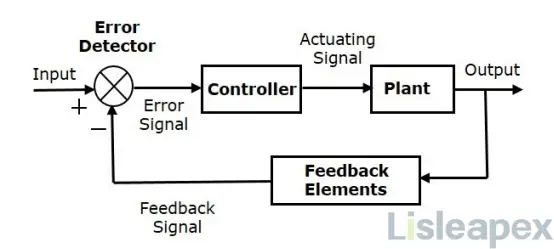
1. Characteristics of Closed Loop Control System
- Negative Feedback Mechanism: Closed-loop control systems incorporate a negative feedback link, enabling automatic adjustment of output compensation and providing resistance to perturbations caused by system parameter changes or external disturbances.
- Enhanced Control Accuracy: By utilizing negative feedback, these systems reduce errors and enhance control accuracy, while also facilitating faster transition processes. However, control quality is contingent upon the accuracy of the feedback elements.
- Closed-Loop Operation: Closed-loop systems operate in a closed loop, which may introduce stability concerns due to the potential for instability.
- Effective Suppression of Perturbations: The negative feedback mechanism in closed-loop systems enables effective suppression of disturbances within the feedback loop, allowing for precise control and close tracking of desired signals.
- Automatic Regulation: Closed-loop control systems are often referred to as automatic regulation systems due to their ability to closely follow given signals and adjust control quantities accordingly. The controller within these systems is commonly known as a regulator.
2. Advantages and Disadvantages of Closed Loop Control System
Closed-loop control systems, also known as feedback control systems, continuously monitor the system's output and adjust the input based on feedback signals to maintain desired performance. They offer high accuracy, robustness against disturbances, and adaptability to changing conditions, making them suitable for applications requiring precise control in dynamic environments.
Advantages:
- Accuracy: Closed-loop control systems offer high accuracy and precision by continuously monitoring and adjusting their output based on feedback signals.
- Robustness: These systems are robust against external disturbances and variations, maintaining stable performance even in changing environments.
- Adaptability: Closed-loop systems can adapt to changes in operating conditions, making them suitable for applications where conditions may vary.
- Automation: With their self-regulating nature, closed-loop systems require minimal human intervention, enabling automation of processes.
Disadvantages:
- Complexity: Closed-loop control systems are more complex in design and implementation compared to open-loop systems, requiring additional components and sophisticated algorithms.
- Cost: The complexity of closed-loop systems results in higher initial setup costs and ongoing maintenance expenses.
- Response Time: Closed-loop systems may have slower response times compared to open-loop systems, as they rely on processing feedback signals before making adjustments.
- Dependency on Feedback: Any issues in the feedback loop, such as sensor failures or signal transmission errors, can impact the performance and stability of closed-loop systems.
3. Closed Loop System Example & Application
Example 1: air conditioner
An example of a closed-loop system is the air conditioner (AC). The AC maintains the desired temperature by continuously comparing it with the ambient temperature using a thermostat. When there is a difference between the set temperature and the actual temperature, the thermostat sends a signal to activate or deactivate the compressor accordingly.
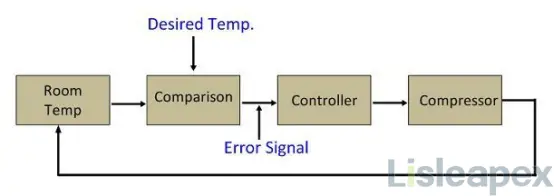
Closed-loop systems like the AC are known for their reliability and accuracy in temperature regulation. However, they come with a higher cost and require regular maintenance to ensure optimal performance.
Example 2: clothes dryer
A typical example of a closed-loop system is the clothes dryer controller, as illustrated in the schematic block diagram provided.
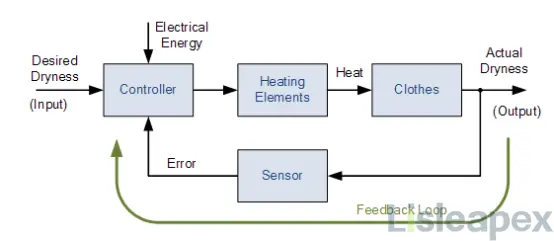
In this system, the desired level of dryness is inputted, and the controller uses this information to regulate the operation of the heating element, which produces heat to dry the laundry. Meanwhile, a sensor continuously monitors the actual dryness of the laundry and compares it with the desired level. Any deviation between the desired and actual dryness levels generates an error signal, which is fed back to the controller. The controller then adjusts the heating output accordingly to minimize the error and achieve the desired dryness level. This iterative process forms a closed feedback loop, allowing the system to maintain precise control over the drying process.
Application:
- Agriculture
- Chemical plants
- Nuclear power plants
- Water treatment plants
- Environmental control
- Cloud orchestration systems
- Industrial control systems (SCADA and DCS)
- Internet of Things (IoT) devices
- Machine learning and artificial intelligence algorithms
Difference between Open Loop and Closed Loop
In essence, open-loop control systems lack feedback, relying solely on input for control, while closed-loop control systems utilize feedback from the output to adjust control action. Here's a comprehensive breakdown:
|
Basis of Comparison |
Open-Loop Control System |
Closed-Loop Control System |
|
Definition |
Control action independent of output, no feedback path provided. |
Control action dependent on output, feedback path present. |
|
Also called |
Non-feedback system. |
Feedback system. |
|
Control action |
Independent of output, unaffected by system's response. |
Dependent on output, adjusts based on system's response. |
|
Design complexity |
Simple design and construction. |
More complex design and construction. |
|
Main Components |
Controller and actuators/processes. |
Controller, actuators/processes, feedback elements, error detector. |
|
Reliability |
Less reliable due to lack of feedback correction. |
More reliable due to feedback adjustment mechanism. |
|
Accuracy |
Relies on calibration, may be less accurate. |
Generally more accurate with feedback mechanism. |
|
Stability |
Strong stability, output remains constant. |
Relatively lower stability, influenced by varying inputs. |
|
Response |
Faster response, no output measurement. |
Slower response, feedback adjusts control action. |
|
Calibration |
Challenging calibration due to lack of feedback. |
Easier calibration with feedback for constant adjustments. |
|
System Interference |
More susceptible to disturbances without correction mechanism. |
Less affected by disturbances due to feedback correction. |
|
Linearity |
Can exhibit non-linearity without adaptive response. |
Tends to be more linear with feedback adjustments. |
|
Maintenance |
Requires less maintenance. |
Needs more maintenance due to feedback system complexity. |
|
Implementation |
Easy to implement. |
Complex implementation due to feedback integration. |
|
Cost |
Less expensive. |
More costly due to feedback components. |
|
Examples |
Traffic lights, automatic washing machines, TV remotes. |
Air conditioners, temperature control systems, refrigerators, toasters, radar tracking systems. |
Industry: Why Closed-Loop Testing System is Important in Materials Testing
In the materials testing industry, closed-loop testing systems play a crucial role due to their ability to provide accurate and repeatable test results. Unlike open-loop systems, closed-loop systems incorporate a feedback mechanism that continuously monitors and adjusts the test parameters in real-time. This ensures that tests are performed to specification, leading to high confidence in the measured material properties.
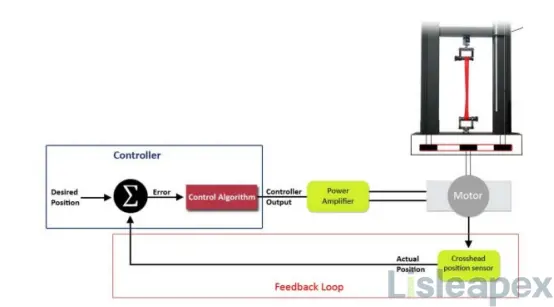
Closed-Loop Material Testing System Diagram
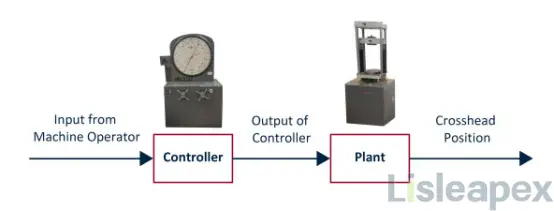
Open-Loop Material Testing System Diagram
Closed-loop testing systems offer several advantages over open-loop systems:
- Accuracy and Repeatability: Closed-loop systems provide precise control over test parameters, resulting in accurate and repeatable test speeds. This is essential for ensuring consistency in test results, allowing for reliable comparisons between different machines, testing laboratories, and published values.
- Strain Rate Sensitivity: Many materials exhibit sensitivity to the speed at which they are tested. Closed-loop systems can maintain accurate and constant strain rates, ensuring that tests are performed at the desired speed as specified by test standards. This is particularly important for materials that undergo changes in strength or ductility at different strain rates.
- Automation and Efficiency: Closed-loop systems are often automated, reducing the risk of human error and optimizing testing conditions based on predefined criteria. This improves efficiency, especially in long-duration experiments or when conducting repetitive tests. Additionally, closed-loop systems can provide real-time monitoring of test parameters, allowing for adjustments as needed during testing.
- Safety: Closed-loop systems can be equipped with safety features and emergency shutdown mechanisms, enhancing overall safety during testing. Safety shields and interlock switches ensure safe operation, especially when dealing with materials that might undergo unexpected changes or failures.
- Versatility: Closed-loop testing systems are versatile and can be adapted for various testing scenarios, making them suitable for a wide range of material testing applications. Integration with advanced controllers and software allows for customization and optimization of test procedures to meet specific testing requirements.
Overall, closed-loop testing systems offer superior performance, reliability, and flexibility compared to open-loop systems, making them indispensable tools in the materials testing industry for achieving accurate and consistent test results.
Conclusion
In summary, the disparity between open-loop and closed-loop control systems lies at the heart of their design and functionality. While open-loop systems offer simplicity and straightforwardness, closed-loop systems excel in accuracy, adaptability, and stability through feedback mechanisms. Understanding the nuances between these control paradigms is crucial for engineers, technicians, and researchers alike, as it informs the selection of the most suitable control strategy for a given application. As technology advances and systems become increasingly complex, the distinction between open-loop and closed-loop control systems remains pivotal in optimizing performance, ensuring reliability, and driving innovation across diverse industries and sectors.
FAQ
-
What is a control system?
A control system is a system that manages, commands, directs, or regulates the behavior of other systems or devices to achieve desired outputs or goals. It involves the use of feedback mechanisms to adjust and maintain system performance.
-
What are the main types of control systems?
Control systems can be broadly categorized into two main types: open-loop control systems and closed-loop (feedback) control systems. Open-loop systems operate without feedback, while closed-loop systems utilize feedback to adjust and maintain system behavior.
-
What is the difference between open-loop and closed-loop control systems?
The main difference lies in the presence of feedback. Open-loop systems do not use feedback from the output to adjust the control action, while closed-loop systems incorporate feedback to regulate system behavior and achieve desired performance.
-
What are the components of a control system?
The components of a control system typically include sensors or transducers to measure system outputs, a controller to process feedback information and generate control signals, actuators to execute the control commands, and feedback mechanisms to provide information about system performance.
-
What is feedback in a control system?
Feedback in a control system refers to the process of comparing the system's output to a reference or setpoint and using the difference (error) to adjust the control action. Feedback enables the system to self-regulate and maintain desired performance despite disturbances or variations.
-
What are some examples of control systems in everyday life?
Examples of control systems in everyday life include thermostat-controlled heating and cooling systems in homes, automatic washing machines with preset cycles, electronic stability control (ESC) in vehicles, and automatic speed control in elevators and escalators.
-
How do control systems contribute to efficiency and productivity in industrial processes?
Control systems play a crucial role in optimizing industrial processes by regulating parameters such as temperature, pressure, flow rate, and speed. By maintaining optimal operating conditions and minimizing deviations from setpoints, control systems improve efficiency, productivity, and product quality.
Stay updated with Lisleapex by signing up for the newsletter


 Congratulations On Your Successful Submission
Congratulations On Your Successful Submission
 Submission Failure
Submission Failure